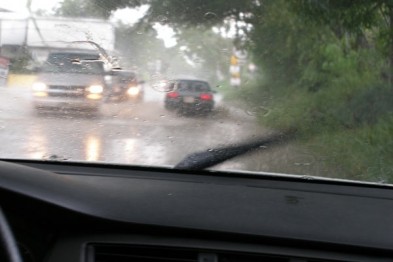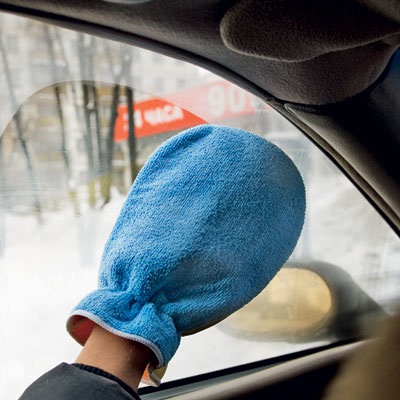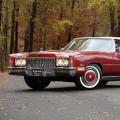The loss of moisture in the form of condensation on the windows of a car is a natural and inevitable process, from the point of view of the laws of physics, but unpleasant and annoying for the driver. Everyone's windows fog up, regardless of the brand of the car and its value.
Reasons for fogging car windows.
1. Weather conditions and temperature differences in the environment.
In rainy weather and in winter time condensation on the windows appears most often. In the first case, moist air enters the passenger compartment through the supply ventilation and is deposited in the form of small water droplets on the windows. In winter, the windows sweat due to the temperature difference between the glass and the ambient air.

2. Increased humidity in the car.

3. Design features of the car and malfunctions in the ventilation system.
Glass fogging can be caused by technical issues car:
- Exhausted resource cabin filter, requires replacement.
- Broken or faulty ventilation system deflectors.
- Antifreeze is leaking from the cooling system into the vehicle interior.
The driver must consider design features your car. If the space under the air intake grille (frill) of the MersedesBenzGLK is not thoroughly cleaned of snow, then no manipulation of the heating and ventilation control buttons will save you from intense fogging of the windows.

Hyundai Getz owners, whose windows sweat in the rain in summer, glue the drip tray with heat-insulating material to prevent condensation from entering the passenger compartment when it rains. Water vapor is generated by the heating of rain streams in the drip tray with the engine running and is sucked into the air intake opening and then settles on the windows in the car. A cabin filter, even a new one, is not able to cope with so much condensation and only partially retains it.
Ways to prevent fogging of car windows.
1.In the parking lot, before the start of the trip.
After starting the engine, wait 5-7 minutes, having previously performed the following steps:
- Weather permitting, open doors or windows and ventilate the interior to remove condensation that has accumulated overnight.
- In winter, turn on the heating of the windshield and rear window, as well as the interior heater, directing warm air using the interior vents to side windows.
- If you're in a hurry, wipe down the misted glass with microfiber cloths or paper towels.

Important! Removing condensation from the windows of the car before driving will eliminate the need to do this during the trip, which reduces the likelihood of emergency.
2.Misting of windows during a trip.
If the windows begin to fog up intensively some time after the start of the trip, then you need to do the following:
- Disable interior air recirculation. Outside air does not enter the passenger compartment when recirculation is on, and therefore all moisture is captured and actively condenses on the car windows. Providing the flow of air from the outside, we get dry glasses and good overview roads.

- Turn on the air conditioner for a while.
- Open the windows (hatch) in the passenger compartment. A simple but effective measure. Some of the discomfort from cold air is compensated for by the rapid restoration of good visibility.
Preventive work to prevent glass fogging.
1.Dry and ventilate the interior regularly (especially after washing the car).
2. Timely change the cabin filter, which improves the ventilation of the cabin.

3.Check and, if necessary, clean the drain holes to drain the condensation formed during the operation of the air conditioner and the stove.
4. In winter, wash the glasses with warm water and soap, which prevents the formation of condensation.
5. To keep one of the windows ajar, which helps to equalize the temperatures outside and inside the car.
6.Use special means (anti-rain, anti-fogging).
Types of glass fogging protection.
1. Anti-fog wipes.

Three-layer napkins made of acrylic and polyethylene are impregnated with a special surfactant and alcohol. They have a double effect - they clean the glass surface and at the same time prevent it from fogging up, providing a good view of the driver.
2. Liquid and aerosol anti-fogging agents.

A thin layer of the substance is applied to the cleaned and dry surface of the glass and polished with a rag to shine. The resulting polymer film prevents moisture from condensing and provides good visibility.
3.Nanoprotection against fogging.

After treatment with this agent, a molecular film with high hydrophilic properties forms on the glass surface, which prevents the formation of water condensation.
Prices for some anti-fog products car glass are presented in table 1.
The selection of auto chemistry products with a hydrophilic effect is not an easy task. After applying anti-fogging agents, stains remain on the windows or glare appears, impairing the driver's visibility. The main thing is to find out the cause of the sweating of glasses and eliminate it in one of the described ways, not forgetting about preventive measures.
Basic, main criterion safe transport management - high-quality visibility.Fogging windows in the car- a problem for many drivers. Precipitation, darkness make it difficult to carefully perceive the traffic situation. homethe reason for the fogging of windows in the car- difference, temperature difference. The interior air is warmer, so moisture accumulates on cold windows.A lot of drivers have a question, why don't car makers install wipers inside? In winter, the windows fog up from the inside. Solving the problem, over and over again you have to wipe them with a rag. Continuous wiping of the surface can interfere with handling. It is difficult for the driver to concentrate, he is constantly distracted, he can become a participant in an accident. Solve the problem by warming up, drying the air inside the machine. However, there are some tipsin the fight against glass fogging.
Causes of the problem
The problem arises from the evaporation of moisture. The main irritant is water, steam generated by its condensation. Weather conditions affect its appearance.Liquid, the gases do not escape well due to the closed space. Understand the situation by looking at a few examples.
Do you shower while closing the bathroom? Notice, mirrors, shower stall fog up. The surface seems to be covered with steam. There is an accumulation of subtle, tiny particles of water.
In other words, the process is called condensation - the formation of a liquid state of water into a gaseous state.
In winter, in summer, there is a difference in room temperature with outdoor indicators. Windows are the border between temperature conditions inside (salonauto) and outside.
Poor weather conditions are another cause of condensation. In summer, the cooling mode of the air conditioner works, and the outside air is much higher. Maximum evaporation occurs. Note that the outside of the car is warmed up by the sun, the interior is much colder, as a result the inside of the car gets wet.
Condensation windows in the car in winter exactly the opposite happens. It's hot inside, cold outside. The evaporation problem reappears. In early autumn, spring is cool enough, it rains, humidity increases. The result remains the same - visibility is lost again. The question arises,what to do? How to get rid of fogging glasses? It is possible to solve the problem. Let's consider the main ways to resolve the situation.
How to deal with fogging in a car?
The ways prevent fogging
A simple solution is to wipe the windows with a regular rag. The situation will be resolved, but after a few minutes it will again disturb the driver. Carrying out the procedure while driving is not recommended. There is a risk of creating an emergency that could result in a series of unpleasant consequences.Put awaymoisture behind the cabin is problematic. We'll have to stop the car, losing precious minutes, strength, nerves.
Determining the causes of evaporation will help to effectively resolve the issue. Minimize the temperature difference.
Is the vehicle air conditioned? Turn on the blowing mode, the gap will be reduced.
It is allowed to lower the windows, but passengers and the driver will feel discomfort, especially in winter. Yet,how to avoid fogging? Use the following tips:
- Start heating first.
- Next, turn on the interior heating, direct the air from the ventilation columns along the damp windows. Be careful. A cardinal temperature difference will lead to destruction, splitting of the holes.
- Use recirculated air mode. The circulation system will help remove excess moisture.
- After fixing the problem, turn off the recirculation mode. The non-switched off circulation system forms condensate again.
- In winter, turn on the wipers; it is dangerous to clear frozen snow. Cleaners can break, scratch or scuff.
These methods are not effective enough, they are outdated long ago. In addition, it is better to carry out all procedures without passengers. The driver, passengers will inhale excess moisture, harmful vapors, gases, endangering health.
How to eliminate fogging of glass in car
So, how to get rid of fogging glasses? Initially, it is necessary to correctly configure the climate control system, select the required airflow mode, increase the temperature, direct the air flow of the deflectors outward. The air conditioner will be able to dry the air in minutes. Disable internal circulation mode.
Does the climate system warm up poorly, dries the air? Check the cabin filter. It may have absorbed excess moisture, it may need to be replaced.
The cardinal solution to the problem is to cover the surface with a special film. The shell is like tinting film. Entrust the application to a professional.
Avoid getting water, snow into the car interior. When heated, the liquid evaporates, settles on cold windows. Wipe off excess moisture from rugs regularly. Due to constant humidity in the machine - it is checkedsealing- a bent seal can be a source high humidity as well as the cause of metal corrosion. The presence of wet cleaning rags will affect evaporation. There is a hood and a trunk for storing them. A household way to reduce evaporation is to put under backseat a bag of salt.
Passengers are often the source of moisture. The air exhaled by passengers is much warmer than the surrounding air. Note that when several passengers travel at the same time, you have to constantly adjust the climate. A common reason is the consumption of alcoholic beverages by passengers. Alcohol absorbs moisture especially, evaporating it under windows. The car attracts additional attention of the traffic police. Advise passengers not to abuse it on the eve of travel.
An effective solution to the situation is to purchase a special productfrom fogging car windows... The modern market offers a huge variety of them - aerosols, wipes,spray. Anti-fogging agentwill help to quickly and effectively resolve the situation. The principle of operation of car cosmetics is simple - to change the properties of surface tension. The solution forms a film. The coating helps the smallest particles of water roll off, creating high-quality visibility. Sometimes the water remains, but it lies in a transparent thinnest layer. Apply the product over a clean, dry surface, repeating the procedure as needed. You should find a drug that is right for you, based on the result, smell, method of application.
 Alsobadvisibility is eliminated by household methods. Usefolk remedies for fogging windows in a car... Evaporation was always a problem, so the drivers found several solutions.How to processsurface? Apply a solution of 10 parts alcohol to one part glycerin. Using glycerin alone, the plane will become greasy, and strong reflections are formed, impairing visibility at night. Many drivers advise wiping down the surface with a newspaper. Printing ink contains substances that create protective film... Another tip is to rub it with cigarette tobacco. To ridcar glass fromcondensation by some folk ways quite absurd. It is unlikely that the driver wants to rub the car with tobacco or take a minute to solve chemical problems. It is better to use proven drugs from quality manufacturers.
Alsobadvisibility is eliminated by household methods. Usefolk remedies for fogging windows in a car... Evaporation was always a problem, so the drivers found several solutions.How to processsurface? Apply a solution of 10 parts alcohol to one part glycerin. Using glycerin alone, the plane will become greasy, and strong reflections are formed, impairing visibility at night. Many drivers advise wiping down the surface with a newspaper. Printing ink contains substances that create protective film... Another tip is to rub it with cigarette tobacco. To ridcar glass fromcondensation by some folk ways quite absurd. It is unlikely that the driver wants to rub the car with tobacco or take a minute to solve chemical problems. It is better to use proven drugs from quality manufacturers.
Anti-fogging agent- the correct solution to the problem
A huge amount of special machine cosmetics will help to solve the condensation issue. Choose a product based on the price category, the desired result, the manufacturer. Domestic goods are sometimes not inferior to imported ones. The principle of operation of anti-fogging agents is quite simple: the accumulation of moisture stops, the condensate flows straight down. The surface becomes smooth.
A productive solution would be to install heaters on the rear-view mirrors and car windows. They are thin wires. Turning on the heating, an electrical impulse is applied to the wires, as a result of which the surface becomes transparent.
Every motorist who operates a car in the autumn-winter period is familiar with the phenomenon of fogging the windows in a car. Question: "Why do the windows fog up in the car?" originated at about the same time as the car itself. This phenomenon significantly impairs the view, which creates a prerequisite for inappropriate driver action. Misted glass is the cause of many.
Driving with foggy glass is not a very pleasant pleasure
Let's try to understand the problem comprehensively. In our opinion, it consists of three components:
- Reasons to facilitate the process.
- Effective elimination methods.
- Products that provide effective anti-fogging.
- Causes of fogging windows in a car
Almost every car enthusiast asked himself the question: "Why do the windows in the car sweat?" The main factor influencing this process is the increase in the moisture content in the air in the car. Misted glass of a car is the result of condensation of moisture contained in the air "spent" by the human body. In addition, in every modern car there are several more sources of high humidity: moisture-accumulated noise insulation, water in pallet mats, wet upholstery, etc. Turning on a fan that draws warm air is usually ineffective, since an increase in the air temperature in the car interior contributes to an increase in the intensity of moisture evaporation, and, consequently, fogging of the windows.
In addition, one of the factors affecting the fogging of the windows in a car is a clogged drain hole in the climate control system, which prevents condensation from draining out.
So, we understand why the windows in the car fog up. How to deal with this phenomenon?
- Ways to solve the "Misted glass" problem
The fight against fogging of glass in a car involves two methods - prevention and elimination of the consequences. The first is undoubtedly a higher priority, since it allows not only to eliminate such a phenomenon as fogging, but also to maintain functionality and performance characteristics automotive glass.
Preventive measures consist in the processing of automobile glass with special substances - "antiperspirants", which prevent the formation of fogging. Means for fogging glass in a car are produced in two states of aggregation: aerosol and liquid. The main problem affecting the choice of means that prevent glass fogging in a car is a combination of two factors: the level of their quality and the motorist's observance of the rules for their use. Application of preparations Low quality on car glass leads to the formation of stains and streaks on the treated glass surfaces, which create significant difficulties when maneuvering in adverse weather conditions and at night.
Now about what to do when the fogged glass is a fait accompli. We offer some powerful practical tips:
- In the process of warming up the car interior, all available devices must participate: rear window heating, heating, blowing, air conditioning, recirculation systems;
- The process of effectively warming up the passenger compartment involves complete absence in it (cabin) passengers;
- Dry the noise barriers and rugs periodically;
- Monitor the condition of the filter that absorbs excess moisture;
- Ventilate the cabin at the end of each ride.
- Anti-fogging products for car windows
Let's start with the so-called "folk" means of fighting this phenomenon.
There are still many motorists who are sure that if it fogs up windshield, it is necessary to turn to the "old-fashioned" method - rubbing with salt. This method is the most barbaric of all currently known, since it has low efficiency, damages glass, promotes the occurrence of corrosion phenomena, etc.
One of the chemicals used to prevent fogging of glass in a car is glycerin. However, it is also not ideal, as the glycerine film tends to generate glare that impairs the view. In addition, she corny stains the interior and clothes of passengers.

Another means of solving the problem will be modern chemical "anti-fogging" - liquids and sprays. The quality of their work depends on the manufacturer, chemical composition and compliance with the conditions of use (application to dry and clean glass).
Modern manufacturers offer potential buyers a fairly wide range of modern chemistry products that help to make car glass clean and clear: "K2 FOX", "Triton", "Sintec". However, as you know, everything is learned in comparison.
With the onset of cold weather, many drivers are united by the same problem: the windshield in the car fogs up, not only in rain or snow, but also in dry weather. This phenomenon is especially dangerous in winter, when an ice crust begins to form almost immediately on the glass, so it is advisable to eliminate the causes before the onset of cold weather.
Why does the windshield fog up
Before overcoming the fogging of glass in a car, you will have to figure out why this phenomenon occurs. In fact, the only reason for fogging is high humidity in the car. It remains only to find out where it comes from.
- First, moisture is contained in the air exhaled by everyone in the cabin. By the way, the well-known pun "the glasses from the inside sweat - drink less" has a real basis, because alcohol vapors (due to their hygroscopicity) collect a lot of moisture around them, so the car windows fog up even more intensely. It is worth noting that the less people talk in the cabin, the less humid air is exhaled, and the slower the moisture settles on the glass.
- The second reason for the increased humidity in the car is wet clothes, rugs, seats, so in the rain the problem is exacerbated. The moisture gradually evaporates and immediately condenses on the windows. Many car owners are perplexed: why the stove is on, the fan is running, and the windows are "tightened" even more. The reason is very simple: the hotter and more intense the airflow, the faster the moisture evaporates.
- The third reason leading to the problem is worn-out door and glass seals, through which water enters the passenger compartment. Determining when it is time to pay attention to sealing is quite easy: if the floor upholstery and the rear shelf constantly get wet in the rain, then the seals are not doing their job. Moreover, their appearance can also say a lot: as they wear out, cracks and tears begin to appear in them.
- Another reason for the fogging of the windows from the inside of the car (although quite rare, but still found in cars with) is a clogged air conditioner drain hole. Condensation, instead of flowing out, remains inside the system, and the passing air is excessively humidified. In this case, to cope with the problem of fogging, it is enough to clean the drain hole.
- In addition, the problem may lie in the jammed air duct dampers, due to which the air flows are incorrectly redistributed. To repair them, you will have to disassemble the dashboard. The procedure, of course, is troublesome, but necessary.
How to deal with fogging glasses
The most reliable way to prevent glass fogging is heating. If it fogs up rear glass- everything is simple: just turn on its heating, and all the condensate will evaporate. Many modern cars, the windshield is also equipped with electric heating. As for the rest, the main thing is to prevent moisture settling. The air flows must be redistributed so that as much as possible more air hit the windows. 
Modern cars have the function of intensive blowing of the windshield, thanks to which even completely fogged glass can be quickly made transparent. Often enough air also gets on the side windows, clearing them.
It is important to note one circumstance: the air for blowing should not be taken from inside the cabin, where it is humid, but from the street. A clogged cabin filter is often the cause of fogging car windows. Its permeability deteriorates, and part of the air is captured from the passenger compartment, so you need to monitor its condition and change it in a timely manner. In addition, a charcoal filter can be purchased instead of the usual one. It dries up the air passing through it, and the glass, not only the windshield, but others as well, fog up less.
On a car equipped with air conditioning, you can turn it on in parallel with the stove, if possible. The air passing through the air conditioner becomes less humid. On a car with a climate control system, this function is usually automatic.
It has long been noticed that the less often the driver washes the windows, the more condensation settles on them. Therefore, it is necessary to wipe them regularly. In addition, clear glass does not give glare at night when the vehicle is illuminated by oncoming traffic, thus making driving safer.
As for the rugs, it is necessary to regularly shake off snow, ice and water from rubber mats, and textile mats need periodic drying, especially if the car was driven in the rain. Many car owners put newspapers under their feet in winter. It also makes sense, because paper absorbs water well. You just need to constantly change them, because otherwise, it is the newspapers that become the source of increased air humidity in the car. 
Using anti-fogging products
There are various aerosols that prevent moisture condensation on glass, but choose an anti-fog agent carefully. Some formulations, when sprayed, form a greasy film on the glass, which is highly reflective in the headlights. Quality products are quite expensive, but when used correctly, they are completely invisible and do not require subsequent removal. It should be remembered that any anti-fogging agent is an extra "chemistry" that will be constantly present in the cabin, and even a high-quality composition should be used with caution.
The grandfather's method of rubbing the windshield of a car with salt wrapped in a rag, thereby eliminating the possibility of fogging, is better not to use, since salt water flowing from the glass will become a source of corrosion, and where the window is blown by the stove, white salt stains will appear, through which you can see what - or very problematic.




